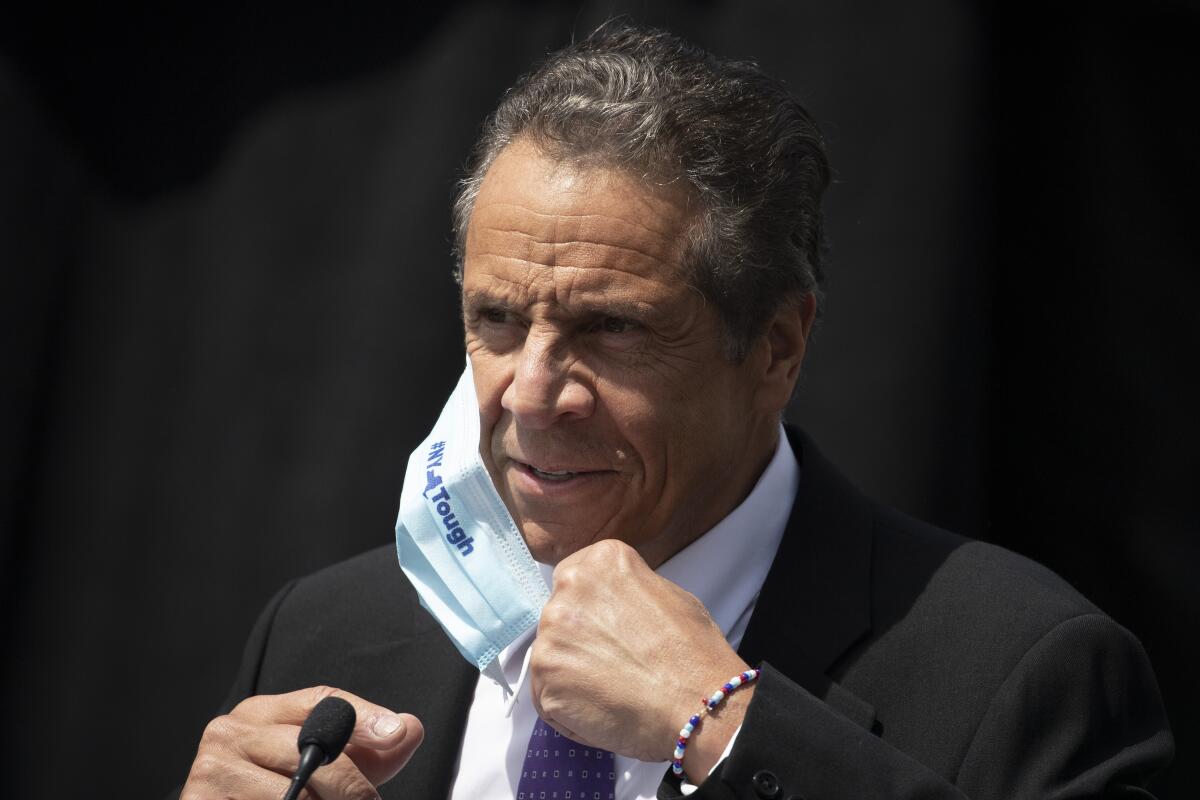In its COVID ruling, Trump’s activist Supreme Court gives us a preview of what’s to come

- Share via
In a pandemic, the Constitution accords the government great latitude to act to stop the spread of a communicable disease. Until about midnight on the evening before Thanksgiving, the Supreme Court had largely honored that principle and upheld restrictions imposed by governors, including on religious gatherings, to stop the spread of COVID-19.
In a very troubling decision late Wednesday, the court, by a 5-4 vote, changed course and barred New York Gov. Andrew Cuomo from putting restrictions on religious gatherings. This shift in approach is entirely the result of Justice Ruth Bader Ginsburg’s death and her replacement by Justice Amy Coney Barrett.
Twice earlier this year the Supreme Court considered challenges to limits on gatherings for religious worship. In both instances, the court sided with the government in 5-4 votes, ruling against the churches seeking injunctions. Four of the justices in the majority on those votes — Chief Justice John G. Roberts Jr. and Justices Stephen G. Breyer, Sonia Sotomayor and Elena Kagan — voted to uphold Cuomo’s restrictions. The majority’s fifth vote previously, was Ginsburg. This time, Barrett joined with the justices who had previously been in the minority.
In the case South Bay United Pentecostal Church vs. Newsom, on May 29, the court refused to enjoin California guidelines that limited attendance at places of worship to 25% of building capacity or a maximum of 100 attendees. Roberts wrote an opinion explaining that gatherings, including for religious worship, can transmit COVID-19. He stressed the need for judicial deference to the decisions of politically accountable officials of the state. He said that “when those officials undertake to act in areas fraught with medical and scientific uncertainties, their latitude must be especially broad.” He explained that “[w]here those broad limits are not exceeded, they should not be subject to second-guessing by an ‘unelected federal judiciary,’ which lacks the background, competence, and expertise to assess public health and is not accountable to the people.” Justices Clarence Thomas, Samuel A. Alito Jr., Neil M. Gorsuch and Brett M. Kavanaugh dissented.
Two months later, on July 24, the court came to the same conclusion in Calvary Chapel Dayton Valley vs. Sisolak, which involved an order by the Nevada governor limiting attendance at religious worship services to 50 people. The same four justices dissented.
But on Wednesday night, the court came to the opposite conclusion in three cases. Once more the rulings were 5-4, but this time the four conservative dissenters from the earlier cases were joined by the newest justice, Barrett. Roberts and the three liberal justices were in dissent.
The court’s ruling on Wednesday night, involving cases brought by the Roman Catholic Diocese of Brooklyn and two Orthodox Jewish synagogues, challenged a New York executive order restricting attendance at houses of worship. The decision was deeply disturbing.
To begin with, it was unnecessary. The restrictions the court barred had already been eased by New York in response to lessening risk in the areas where the houses of worship were based. Courts are supposed to avoid unnecessary constitutional rulings, and there was no need for the court to issue an injunction on restrictions that no longer applied. If the greater restrictions were to be reinstated, that would be the time for the court to consider them.
But what is most troubling about the court’s decision on Wednesday night is how much the justices in the majority ignored the context for the restrictions. Astoundingly, neither the opinion for the court nor the concurring opinions of Gorsuch or Kavanaugh mention the seriousness of the coronavirus pandemic. It is not until Breyer’s dissent that it is mentioned that COVID–19 has infected more than 12 million Americans and caused more than 250,000 deaths nationwide. At least 26,000 of those deaths have occurred in the state of New York, with 16,000 in New York City. The conservative justices also failed to acknowledge that the pandemic is surging, not waning. In New York, the seven-day average of new confirmed cases per day has risen from around 700 at the end of the summer to more than 4,800 last week. Nationwide, the number of new confirmed cases per day is now higher than it has ever been.
The court’s conservative majority abandoned the traditional judicial deference to government officials acting to stop the spread of a communicable disease. There is no doubt that this would have come out differently, and followed the decisions from earlier this year, if only Justice Ginsburg and not Justice Barrett was on the court.
Conservatives, led by President Trump, have minimized the seriousness of the COVID-19 pandemic. On the same day as the court’s ruling, Trump encouraged Americans to “gather” for Thanksgiving despite constant warnings to the contrary from public health experts. One would have hoped that the justices on the court would have looked to the medical evidence and at the very least followed recent precedents upholding restrictions on religious gatherings.
But not these activist conservative justices.
Erwin Chemerinsky is dean of the UC Berkeley School of Law and a contributing writer to Opinion.
More to Read
A cure for the common opinion
Get thought-provoking perspectives with our weekly newsletter.
You may occasionally receive promotional content from the Los Angeles Times.









